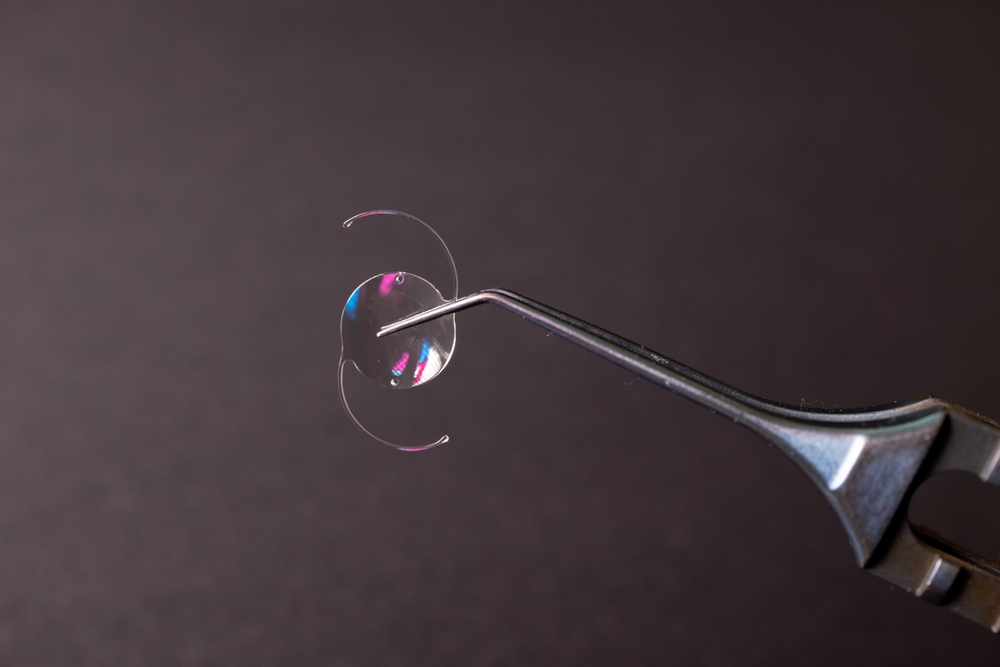Refractive lens exchange (RLE) is a highly successful procedure that provides a long-term solution if you’re seeking to reduce or eliminate your dependence on glasses or contact lenses. One of the most important decisions you’ll have to make for your RLE procedure is determining the best IOL for you.
Keep reading to learn more about what kind of IOL you should choose for refractive lens exchange.
What is Refractive Lens Exchange?

Refractive lens exchange is a vision correction procedure that corrects refractive errors, including farsightedness, nearsightedness, presbyopia, and astigmatism, eliminating or significantly decreasing your dependence on prescription lenses.
RLE is often recommended if you have thin corneas, severe dry eyes, high refractive errors, or early-onset cataracts and don’t qualify for LASIK or PRK.
The simple and quick outpatient procedure is very similar to cataract surgery. The difference between the two is that with RLE, the natural lens is replaced before cataracts form.
An advantage of having RLE is that you won’t develop cataracts in the future. Cataracts can only form on the natural lens, not on the IOL implanted during RLE.
What is an IOL?
An intraocular lens (IOL) is a synthetic lens implanted in the eye. Most IOLs are made of acrylic, silicone, or other plastic. An IOL replaces the natural lens that is removed during refractive lens exchange.
Normally, your natural lens refracts or bends light entering the eye, helping it focus correctly on the retina so you can see clearly.
However, when you have a refractive error, the lens doesn’t bend light accurately.
As a result, light does not focus directly on the retina, leading to blurred vision, among other symptoms.
Once implanted during RLE, the new IOL takes over the role of your natural lens. It refracts light inside the eye and helps it land properly on the retina, improving your vision.
The IOL you choose will contain the appropriate lens power or prescription to give you the best vision after RLE, much like a prescription you would have for contact lenses or glasses.
What Happens During Refractive Lens Exchange?
RLE is performed outpatient and takes about 15 to 30 minutes to complete. You’ll be given anesthetic eye drops to numb your eye. You may also be given medicine to help you relax.
Using a blade or laser, your eye doctor at Cheema MD Eye Care will create a tiny incision in your eye to reach your lens. They’ll then use ultrasound waves to break the lens into fragments and a vacuum system to suction them out.
The new IOL is inserted through the same incision and positioned in the capsule that previously held your natural lens. The incision is so tiny that it closes without stitches, and your vision will start to clear within a few days.
What are the Different Types of IOLs?
Selecting the right IOL for refractive lens exchange (RLE) can dramatically improve your vision. Depending on your vision needs and lifestyle, there are two main types of IOLs to choose from:

Monofocal IOL
A monofocal or standard lens is a single-focus IOL. It provides exceptional clarity at only one distance, either near, far, or in between.
These IOLs improve vision by correcting the way light refracts as it enters your eye.
Most people have monofocal IOLs set for sharp, clear, distance vision. They then wear glasses or contact lenses to achieve a full range of vision.
A monofocal IOL can be a great choice if you don’t mind wearing visual aids for activities that require clear vision at near and intermediate distances.
Multifocal IOLs
Multifocal lenses are an excellent way to expand your range of vision. Unlike monofocal lenses that correct vision at only one distance, multifocal IOLs improve vision at all three distances, eliminating or reducing the need for corrective eyewear.
Multifocal IOLs have a unique structure with multiple concentric zones set at varying powers. These zones direct light to various focal points, allowing clear vision at near, intermediate, and far distances.
Light distribution to these focal points is based on refractive technologies, which enable the eye to adjust to different distances seamlessly.
While multifocal IOLs offer sharp vision at all distances, glasses or contacts are sometimes needed for a few tasks.
What are the Benefits of a Monofocal IOL?
The advantages of monofocal lenses include:
Excellent Clarity
Monofocal lenses provide exceptional clarity at one distance. If you choose far-away vision, things like road signs, the horizon, and people at a distance will appear crisp and defined.
Better Vision in Low-Light
Standard IOLs offer better vision quality in low-light settings. They focus all the incoming light onto one focal point on the retina. This improves contrast sensitivity because light isn’t scattered as much within your eye.
Increased Independence from Prescription Lenses
While you’ll still require visual aids for up-close and intermediate activities, many everyday tasks become glasses or contacts-free, thus enabling greater visual freedom.
What are the Benefits of Multifocal IOLs?

There are many benefits to choosing a multifocal IOL. Some of these are:
Quality Vision at All Distances
Multifocal IOLs provide a wider range of vision. They allow you to see clearly at near, arm’s length, and far away distances, eliminating or lessening the need for prescription lenses.
Improved Quality of Life
With a multifocal lens implant, you’ll have sharp, clear vision whether you’re reading a book, using your laptop, driving, or playing sports.
So you can enjoy more activities, from swimming and playing tennis to camping and traveling, without glasses or contacts getting in the way.
Do you want to determine which IOL is best for you? Schedule an appointment at Cheema MD Eye Care in Kingston, NY, today and change the way you see the world.



